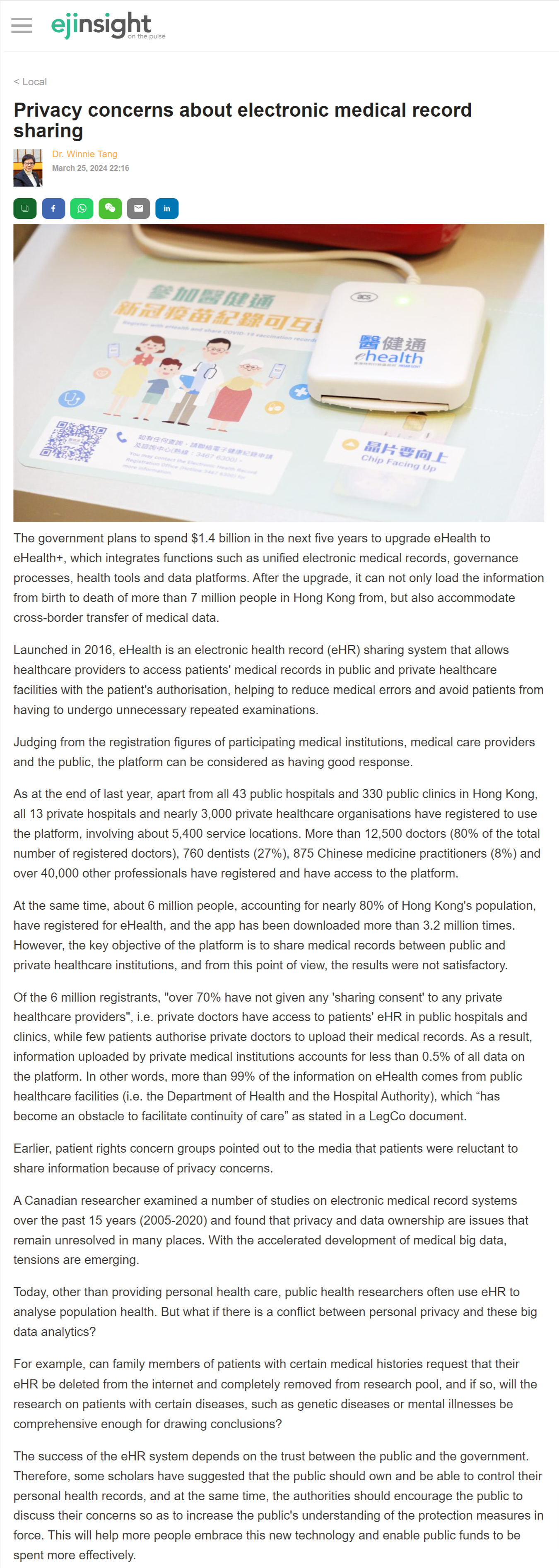網上版請按此

Privacy concerns about electronic medical record sharing
The government plans to spend $1.4 billion in the next five years to upgrade eHealth to eHealth+, which integrates functions such as unified electronic medical records, governance processes, health tools and data platforms. After the upgrade, it can not only load the information from birth to death of more than 7 million people in Hong Kong from, but also accommodate cross-border transfer of medical data.
Launched in 2016, eHealth is an electronic health record (eHR) sharing system that allows healthcare providers to access patients' medical records in public and private healthcare facilities with the patient's authorisation, helping to reduce medical errors and avoid patients from having to undergo unnecessary repeated examinations.
Judging from the registration figures of participating medical institutions, medical care providers and the public, the platform can be considered as having good response.
As at the end of last year, apart from all 43 public hospitals and 330 public clinics in Hong Kong, all 13 private hospitals and nearly 3,000 private healthcare organisations have registered to use the platform, involving about 5,400 service locations. More than 12,500 doctors (80% of the total number of registered doctors), 760 dentists (27%), 875 Chinese medicine practitioners (8%) and over 40,000 other professionals have registered and have access to the platform.
At the same time, about 6 million people, accounting for nearly 80% of Hong Kong's population, have registered for eHealth, and the app has been downloaded more than 3.2 million times.
However, the key objective of the platform is to share medical records between public and private healthcare institutions, and from this point of view, the results were not satisfactory.
Of the 6 million registrants, "over 70% have not given any 'sharing consent' to any private healthcare providers", i.e. private doctors have access to patients' eHR in public hospitals and clinics, while few patients authorise private doctors to upload their medical records. As a result, information uploaded by private medical institutions accounts for less than 0.5% of all data on the platform. In other words, more than 99% of the information on eHealth comes from public healthcare facilities (i.e. the Department of Health and the Hospital Authority), which "has become an obstacle to facilitate continuity of care" as stated in a LegCo document.
Earlier, patient rights concern groups pointed out to the media that patients were reluctant to share information because of privacy concerns.
A Canadian researcher examined a number of studies on electronic medical record systems over the past 15 years (2005-2020) and found that privacy and data ownership are issues that remain unresolved in many places. With the accelerated development of medical big data, tensions are emerging.
Today, other than providing personal health care, public health researchers often use eHR to analyse population health. But what if there is a conflict between personal privacy and these big data analytics?
For example, can family members of patients with certain medical histories request that their eHR be deleted from the internet and completely removed from research pool, and if so, will the research on patients with certain diseases, such as genetic diseases or mental illnesses be comprehensive enough for drawing conclusions?
The success of the eHR system depends on the trust between the public and the government. Therefore, some scholars have suggested that the public should own and be able to control their personal health records, and at the same time, the authorities should encourage the public to discuss their concerns so as to increase the public's understanding of the protection measures in force. This will help more people embrace this new technology and enable public funds to be spent more effectively.
Dr. Winnie Tang
Adjunct Professor, Department of Computer Science, Faculty of Engineering; Department of Geography, Faculty of Social Sciences; and Faculty of Architecture, The University of Hong Kong